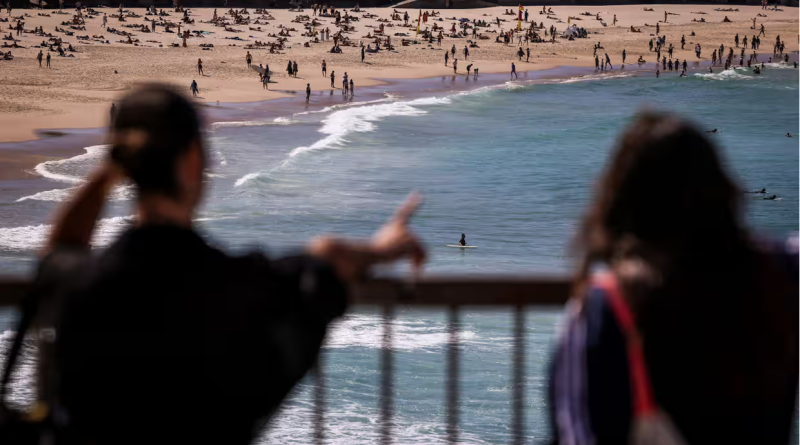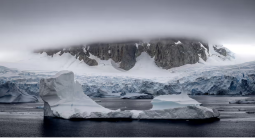Alarm as Australia records ‘gobsmacking’ hot August temperatures

Friday afternoon at Bondi beach in Sydney, where the temperature reached 30C – the hottest August day on record since 1995. Photograph: David Gray/AFP/Getty Images
Australia’s winter runs from June to August, but swathes of the country have felt like summer the past week with temperatures topping 40C and records tumbling.
“It doesn’t matter how you slice and dice it,” said Dr Linden Ashcroft, a climate scientist at the University of Melbourne. “The temperature records have been gobsmacking.”
The national record for the hottest August day was broken on Monday at Yampi Sound in the remote Western Australia Pilbara region, where the temperature reached 41.6C – breaking the previous record of 41.2C set in 2020. On Friday, Sydney had its hottest August day since 1995, passing 30C.
Western Australia, the Northern Territory and South Australia all broke state-high records, and Queensland missed by 0.1C. The SA record of 36.5C which had stood since 1946 was eclipsed with a 39.4C reading in the remote outback town of Oodnadatta, 870 km north of the state capital of Adelaide.
The country’s flora and fauna has already reacted to the early arrival of spring, with flowers and shrubs blooming early. Some alpine areas have seen a crash in snow depth, worrying skiers and prompting warnings for early season closures. On Friday the popular Mt Buller ski field in Victoria called an end to its season.
But what has made the event stand out is not just the extremes, which climate scientists said was down to global heating – it’s the scale.
Bureau of Meteorology maps showed a giant mass of extreme heat from near Brisbane in the east to the interior of Western Australia – a distance of about 3700km.
Data on Wednesday showed 48% of the country experienced maximum temperatures in the hottest 1% on record for August.
Nadine D’Argent, a climatology specialist at the bureau, said there were several “wow moments” as the temperature data came in.
“Seeing 40C in August is quite rare. We generally don’t see that until late September but we’ve had 16 instances where temperatures have gone above 40C.”
D’Argent said August was on track to be the hottest on record. And as the heat started to drift towards the more populated south-east this weekend, she said more records could tumble. The 2024 winter is on track to be in the top three warmest on record.
Brisbane’s daily August highs are usually about a comfortable 23C. But by the end of the week temperatures were well above 30C, with a high of 36C forecast for Saturday. Sydney, usually averaging about 18C in August, saw maximums at 29C this week.
So what’s caused the heatwave?
The climate scientist Prof Sarah Perkins-Kirkpatrick, from the Centre for 21st Century Weather at the Australian National University, is an expert on how climate change is changing extreme heat and heatwaves around the world.
She said the pattern of the heat was “pretty close to what we would see in a summer heatwave”, with the heat building up in the centre and then driving to the south-east.
“Heatwaves need a high pressure system to drive them and that’s what we’ve got now in Australia. It’s big and it has been parked,” she said.
“I haven’t seen this kind of spread of record-breaking temperatures really anywhere. You don’t usually see the whole country light up [with extreme temperatures] like a Christmas tree. It’s a whole lot of summer coming a whole lot earlier.”
High pressure systems deliver clear skies and allow air to descend, heating as it moves, said Dr Martin Jucker, an atmospheric scientist at the University of New South Wales.
There was likely no single cause of the event, he said, but it fits the long-term trend that has seen the country warm by 1.5C since long-term records started in 1910.
“This comes against the background of global temperatures going crazy – and having been crazy – since last May and really refusing to go back to normal,” said Jucker.
Dr Andrew King, a climate scientist at the University of Melbourne, said it was “really unusual” for the entire country to be experiencing above average temperatures over the past week.
“I think there is a large climate change signal in this. It would be very hard to get these temperatures – to get as hot as this – without human-caused climate change.”
Ashcroft said while the heatwave was “astounding” it was not surprising. But she hoped it would spur people into action.
If Australians wanted to spring clean, looking for ways to lower their greenhouse gas emissions or take their money out of fossil fuels would be a good start, she said.
“Maybe this is the spring where people change a few habits to try and make sure our winters don’t get any warmer.”






